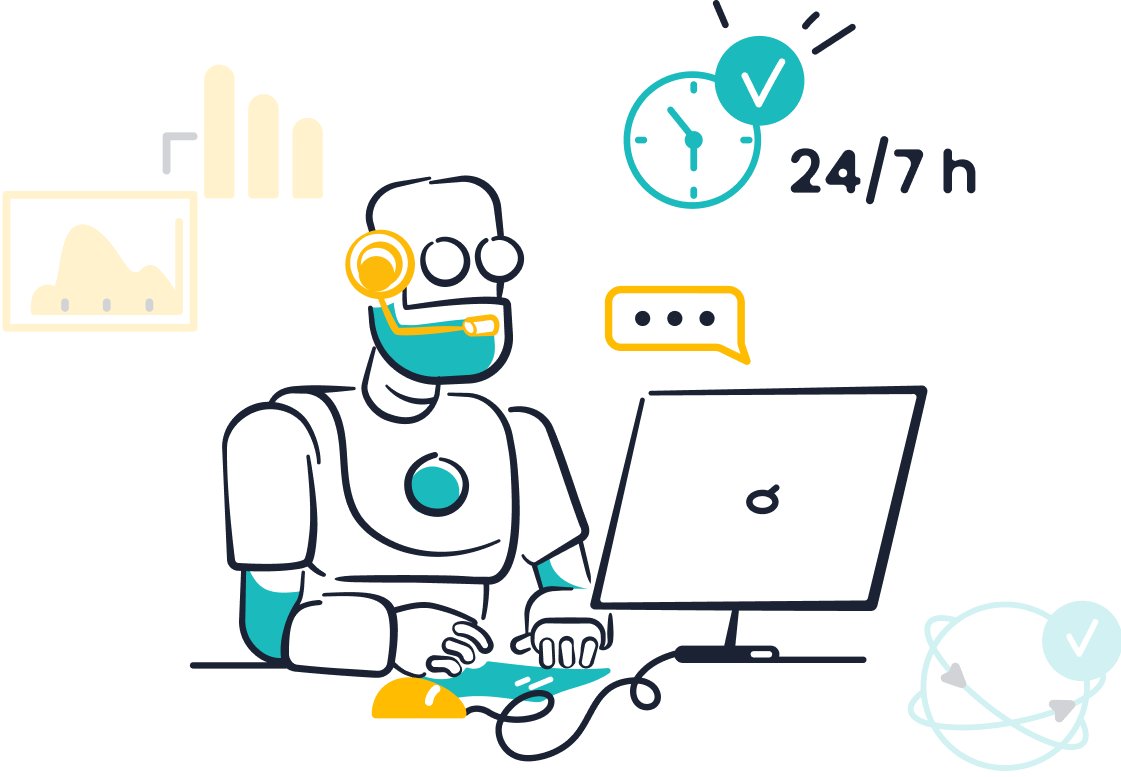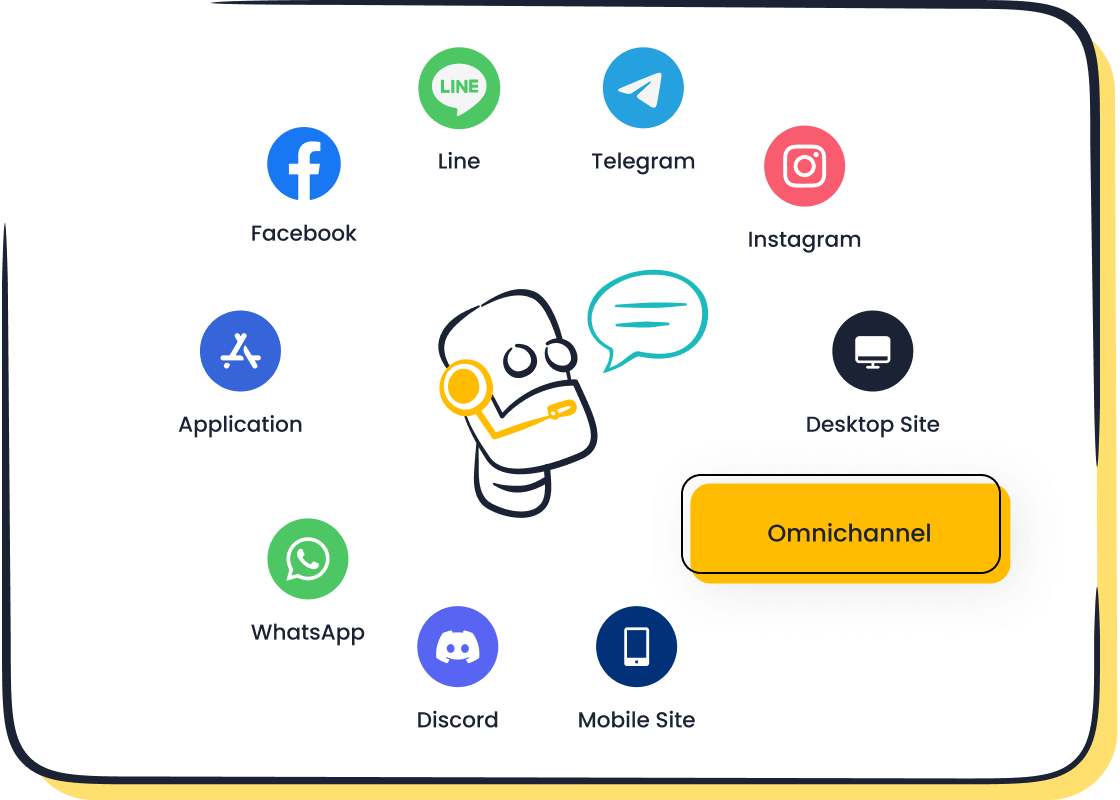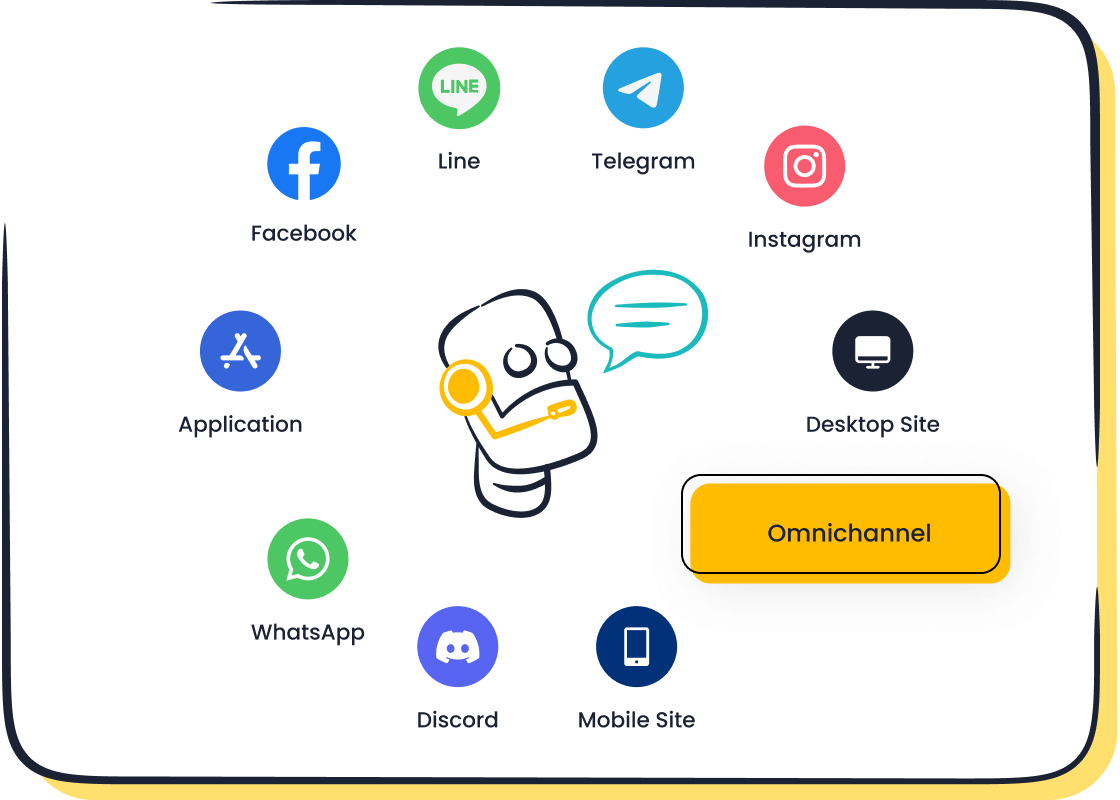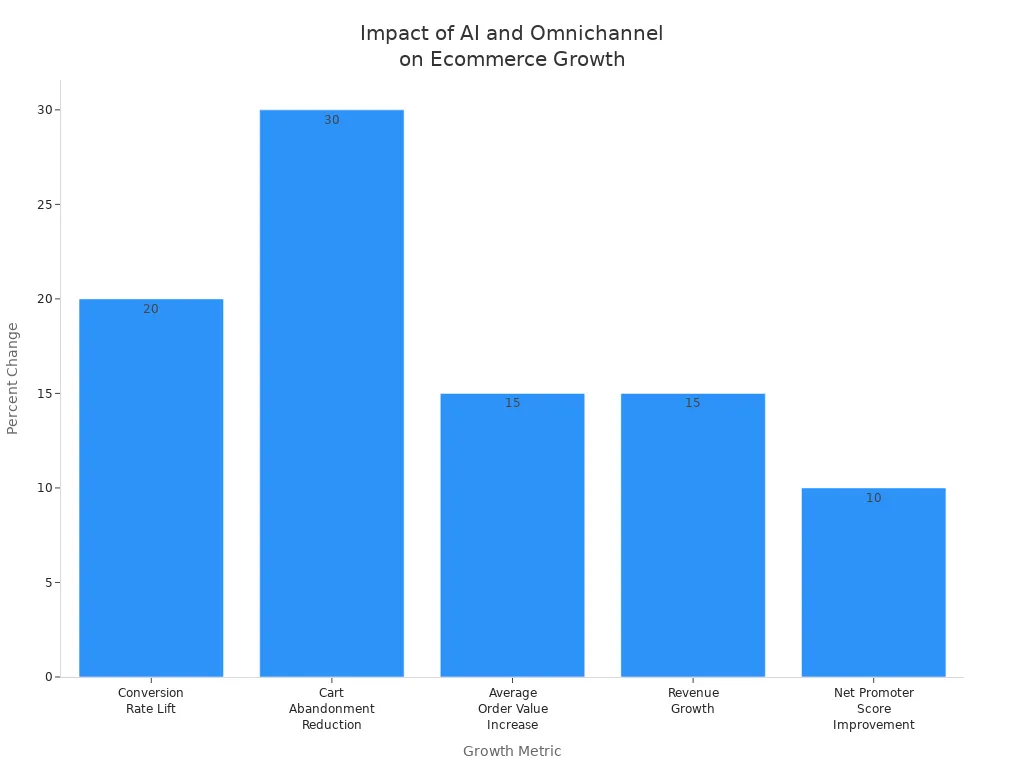Customer Segmentation in Ecommerce: What’s New in 2025

Customer segmentation in ecommerce is evolving rapidly as brands adopt new AI-powered tools and data-driven strategies. Businesses now see a projected 35.9% CAGR for AI segmentation technologies from 2025 to 2030, with 92% planning investments in generative AI.
| Statistic Description | Value/Percentage |
|---|---|
| Projected CAGR for AI-powered customer segmentation market | 35.9% |
| Average increase in customer engagement | 10% |
| Percentage of customers preferring personalized experiences | 80% |
Sobot leads this transformation with innovative solutions like Sobot AI, helping brands create seamless commerce experiences and adapt to new ecommerce trends.
Ecommerce Trends 2025
The ecommerce landscape in 2025 shows rapid transformation. Brands focus on mobile-first shopping, advanced personalization, and seamless social commerce. The table below highlights the most significant ecommerce trends shaping the industry:
| Trend | Description & Significance |
|---|---|
| AI-driven personalization | AI enables highly personalized shopping experiences and dynamic customer segmentation. |
| Data security & privacy | Brands prioritize transparency and secure systems to address consumer concerns. |
| Social commerce | Social platforms become direct shopping channels, blending interaction and commerce. |
| Voice & conversational commerce | Voice-enabled shopping and chatbots improve convenience and engagement. |
| Augmented reality (AR) | AR enhances product visualization, reducing hesitation and returns. |
| Sustainability | Eco-friendly practices and packaging gain importance. |
| Supply chain optimization | AI and automation improve logistics and inventory management. |
| Subscription commerce | Flexible, AI-powered subscription models offer more value. |
| AI-powered customer support | Advanced chatbots deliver efficient, 24/7 service. |
Mobile Commerce Growth
Mobile commerce dominates ecommerce in 2025. Over 70% of purchases now happen on mobile devices, and digital wallets power more than half of online transactions. Brands invest in mobile-first shopping by optimizing responsive design, simplifying navigation, and using large, touch-friendly buttons. Fast loading speeds and streamlined mobile checkout processes, such as guest checkout and mobile wallet integration, drive higher conversion rates. Push notifications and location-based offers boost engagement. Mobile commerce strategies focus on convenience, security, and personalized experiences. Sobot supports these trends with omnichannel solutions that unify mobile and web interactions, ensuring a seamless customer journey.
AR and Personalization
Augmented reality and personalization work together to create immersive ecommerce experiences. Companies like IKEA and Sephora use AR to let customers "try before they buy," which leads to better purchase decisions and fewer returns. AR-driven personalization forms part of broader AI-powered strategies that increase satisfaction and retention. By combining AR with AI and machine learning, brands create micro-segments for ultra-tailored experiences. Sobot’s AI-driven tools help ecommerce brands deliver these personalized journeys, using real-time data to adapt offers and recommendations.
Social Commerce Expansion
Social commerce expands rapidly in 2025. Platforms like Facebook, TikTok, and Instagram integrate ecommerce features, livestream shopping, and AR try-ons. Brands use customer segmentation to target ads and personalize product recommendations for specific audiences. AI and analytics help brands predict trends and optimize campaigns. Livestream shopping is set to account for 20% of social commerce sales. Messaging apps, chatbots, and live chat become essential, with 41% of consumers wanting live chat during online shopping. Sobot’s omnichannel platform enables brands to manage social commerce interactions, unify data, and deliver real-time, personalized support across channels.
Customer Segmentation in Ecommerce
Customer segmentation in ecommerce has changed dramatically over the past decade. In the past, brands grouped customers into broad categories based on simple demographic or geographic data. Today, advanced segmentation uses real-time data, AI, and machine learning to create dynamic, evolving customer personas. This shift allows brands to understand consumer buying behavior more deeply and deliver highly personalized experiences.
| Feature | Traditional Segmentation (Past) | Advanced Segmentation (Current) |
|---|---|---|
| Basis | Static groups based on broad, infrequently updated characteristics | Dynamic, evolving personas reflecting real-time behaviors and needs |
| Data Types | Mainly demographic and geographic data | Multi-dimensional data including demographic, psychographic, behavioral, technographic, and zero-party data |
| Update Frequency | Infrequent updates (e.g., annually) | Continuous or near real-time updates driven by AI and machine learning |
| Technology | Manual analysis and basic statistical tools | AI-powered analytics, predictive modeling, automation, and customer data platforms |
| Primary Use | Targeted marketing campaigns | Foundational business strategy impacting marketing, product development, customer experience, pricing, and sales |
| Persona Type | Static, assumption-based personas | Dynamic, data-driven, continuously evolving personas |
| Privacy Focus | Limited focus, often relying on inferred or third-party data | Privacy-first approach emphasizing consent, transparency, and use of zero-party and first-party data |
This evolution means that customer segmentation in ecommerce now forms the backbone of business strategy, not just marketing. Brands like Sobot help companies unify customer data from every channel, making it easier to adapt to changing consumer needs and behaviors.
Micro-Segmentation
Micro-segmentation takes customer segmentation to a new level. Instead of grouping consumers by age or location, brands now use detailed behavioral data, purchase history, and psychographics to create very small, focused groups. For example, a retailer might target active app users aged 35-50 who buy specific products and respond well to discounts. This approach allows for highly relevant promotions, such as free shipping or special offers, sent through multiple channels.
- Leading ecommerce brands in 2025 work with micro and nano-influencers who have niche, engaged audiences.
- Nano-influencers achieve the highest engagement rates, often over 2.5%.
- Brands use these partnerships for authentic product reviews, live shopping events, and unboxing videos.
- Influencer marketing and user-generated content play a key role in reaching micro-segments.
- Brands prioritize influencers with sector expertise to maintain trust and authenticity.
Micro-segmentation relies on AI and machine learning tools like RFM analysis and intent-based segmentation. These tools help brands identify micro-intent moments, such as when a consumer adds an item to their cart or searches for a specific product. Sobot’s omnichannel platform supports these strategies by unifying customer data and enabling real-time, targeted marketing.
Behavioral Data
Behavioral data is essential for understanding customer buying behavior and consumer buying behavior. Ecommerce platforms collect this data from websites, apps, email, SMS, social media, and even offline stores. Customer Data Platforms (CDPs) bring all this information together, creating a 360-degree view of each consumer.
- Brands group customers by lifecycle stage, channel engagement, purchase patterns, cart abandonment, and loyalty status.
- For example, Remix used behavioral data to automate email campaigns for new users, doubling first purchases.
- Channel engagement data helps brands focus on the most effective touchpoints.
- Purchase and browsing history enable personalized product recommendations, as seen with Sapphire’s 12X ROI from tailored suggestions.
- Cart abandonment triggers personalized web push notifications, boosting conversion rates and revenue.
- Timing-based segmentation targets consumers around birthdays or holidays, making offers more relevant.
- Loyalty segmentation helps brands retain high-value customers by understanding their preferences.
Modern ecommerce platforms use real-time behavioral data to create dynamic segments that change as consumer actions change. AI-driven analytics predict future needs, allowing brands to stay ahead of trends. Sobot’s AI-powered solutions help brands collect, unify, and act on behavioral data, improving both customer experience and operational efficiency.
Essential Segments
Certain customer segments deliver the most value for ecommerce businesses in 2025. Brands must identify and nurture these groups to maximize revenue and customer loyalty.
| Customer Segment | Definition | Why It Matters | How to Use |
|---|---|---|---|
| One timers | Customers with exactly one purchase | High acquisition cost; focus on generating repeat purchases to increase Customer Lifetime Value. | Target for second purchase campaigns, use product analysis and email marketing to encourage repeat buys. |
| Active new signups | Customers who signed up but haven't purchased | New subscribers are most engaged within 48 hours; early engagement boosts conversion chances. | Optimize welcome email sequences with varied content, timing, and incentives to convert signups to buyers. |
| Most likely to churn | Customers at risk of not returning | Retaining customers is cheaper and more profitable; losing customers reduces revenue potential. | Use targeted re-engagement emails with incentives to prevent churn and maintain customer loyalty. |
| Churned customers | Customers who have lapsed beyond buying cycle | Cheaper to win back than acquire new customers; opportunity to re-engage dormant buyers. | Send re-engagement emails encouraging small actions before offering discounts to avoid margin erosion. |
| Loyals | Customers with 3+ purchases | 20% of customers generate 80% of revenue; understanding loyal behavior helps replicate success. | Analyze purchase patterns and marketing channels to double down on effective products and campaigns. |
Brands use these segments to guide their strategy and optimize marketing efforts. For example, Sobot’s ecommerce solutions help brands identify one-time buyers and create campaigns to encourage repeat purchases. By focusing on active new signups and loyal customers, brands can increase customer lifetime value and drive sustainable growth. Understanding consumer buying behavior and acting on real-time customer data ensures that every segment receives the right message at the right time.
Tip: Dynamic segmentation adapts as customer data changes, making it possible to deliver hyper-personalized experiences and improve customer satisfaction.
AI and Automation in E-Commerce

Artificial intelligence and automation have become the backbone of modern e-commerce. These technologies transform customer segmentation in ecommerce by enabling brands to analyze massive amounts of data, predict customer needs, and deliver hyper-personalized experiences at scale. Companies now use AI to process unstructured data from social media, reviews, and browsing behavior, gaining a nuanced understanding of customer preferences. Machine learning models such as collaborative filtering and neural networks predict future actions, allowing brands to anticipate demand and personalize every touchpoint. AI-powered personalization not only increases engagement but also drives higher sales and customer satisfaction. According to recent studies, 75% of companies expect AI to significantly impact their customer segmentation strategies, with 70% citing improved customer experience as a key driver for adoption.
Predictive Analytics
Predictive analytics has revolutionized e-commerce by turning raw data into actionable insights. Brands use predictive analytics to analyze browsing and purchase history, offering tailored product recommendations and promotions in real time. These models help forecast demand, optimize inventory, and reduce overstock or stockouts. For example, dynamic pricing strategies adjust prices based on market demand and competitor actions, maximizing profits. Companies also use predictive analytics to segment customers by behavior and preferences, improving targeted marketing and conversion rates. A telecom provider in India reduced churn by 25% and increased satisfaction by 40% through personalized retention strategies powered by predictive analytics. This approach combines demographic segmentation with real-time engagement data, creating adaptive and continuously refined segments.
Predictive analytics enables proactive engagement, helping brands anticipate customer needs and deliver relevant content automatically. Businesses using AI marketing automation report a 20% increase in sales and a 15% boost in customer satisfaction.
Real-Time Segmentation
Real-time segmentation allows e-commerce brands to respond instantly to customer actions. AI-powered platforms monitor engagement, conversion rates, and behavioral triggers such as repeated product views or cart abandonment. These insights enable brands to send timely, personalized offers that increase conversion rates and reduce cart abandonment. For instance, a fashion retailer saw an 18% rise in conversions by sending discount codes within an hour of repeated product views. Real-time segmentation also helps brands create detailed customer profiles, enabling highly customized marketing and product development. Machine learning models update segments dynamically, ensuring precision as user behavior evolves.
- Real-time segmentation delivers relevant experiences that foster loyalty and sustainable growth.
- Segmenting by customer lifetime value and purchase history helps prioritize high-value users.
- Data-driven marketing companies are six times more likely to be profitable year over year.
- Increasing customer retention by 5% can boost profits by up to 95%.
Sobot Chatbot Solutions

Sobot’s AI-powered chatbot stands at the forefront of e-commerce automation. The chatbot uses advanced AI and predictive analytics to automate customer interactions, solve regular queries, and assist agents, improving productivity by up to 70%. Sobot’s chatbot operates 24/7, handling queries across multiple channels like WhatsApp and SMS, and supports multiple languages. The platform’s real-time segmentation capabilities allow businesses to deliver personalized messages and proactive push notifications based on customer intent and behavior. This approach boosts conversions by 20% and helps brands gain 30% more leads while reducing service costs by up to 50%.
| Sobot Chatbot Feature | Benefit for E-Commerce Brands |
|---|---|
| Omnichannel support | Unified customer experience across all platforms |
| Predictive analytics | Real-time, personalized recommendations and offers |
| No-code setup | Fast deployment and easy optimization |
| Multilingual capabilities | Global reach and improved customer satisfaction |
| 24/7 availability | Always-on support, increasing engagement and loyalty |
Sobot’s AI-powered segmentation and automation tools help e-commerce brands unify data, personalize every interaction, and optimize marketing ROI. By leveraging Sobot’s solutions, brands can stay ahead in a competitive market and deliver the seamless experiences customers expect.
Omnichannel Experience

Unified Customer View
A unified customer view stands at the heart of a seamless e-commerce journey. Companies that consolidate customer data from all channels—online, in-store, and mobile—gain a complete understanding of customer behavior and preferences. This approach allows brands to personalize communications and tailor marketing efforts for each stage of the customer journey. When customer service, promotions, and transactions are integrated, shoppers receive consistent support and messaging. This consistency builds trust and encourages repeated purchases. Empowering staff with access to unified customer information improves service quality and loyalty throughout the commerce experience.
- Integrated customer service handles complaints, returns, and post-purchase needs across all channels.
- Consistent payment processes and personalized recommendations increase customer confidence.
- Real-time tracking of customer interactions enables prompt responses and efficient support.
Data Integration
Leading e-commerce brands break down data silos by linking offline and online information. They use advanced identity resolution to connect in-store purchases, loyalty programs, and website activity, creating a single source of truth for each customer. For example, brands use QR codes on physical marketing materials to track offline engagement and connect it to online profiles. Sephora uses location-based marketing to send in-app notifications in-store and follows up with personalized emails, showing how data integration enhances segmentation and personalization. By integrating data warehouses and cloud platforms with customer data platforms, brands process information in real time and gain deeper insights into the customer journey.
Sobot in Action
Sobot’s omnichannel solution empowers e-commerce brands to unify customer data and deliver seamless experiences across mobile, web, and offline touchpoints. Companies using Sobot report a 25% increase in customer engagement and a 20% rise in sales. Sobot’s AI-powered chatbots automate over 40% of routine tasks, allowing teams to focus on high-value activities. Opay, a leading financial service platform, improved its customer satisfaction from 60% to 90% after adopting Sobot’s omnichannel tools. The platform enabled Opay to manage customer interactions across social media, email, and voice channels, resulting in a 17% increase in conversion rates and a 20% reduction in costs. Sobot’s unified approach ensures that every commerce interaction feels personal and efficient, supporting long-term loyalty and growth.
Personalization and Customer Buying Behavior
Understanding customer buying behavior has become essential for delivering personalized shopping experiences in ecommerce. Brands now use advanced AI tools to analyze consumer actions, preferences, and feedback. This approach allows companies to create hyper-personalization strategies that boost customer experience and drive loyalty.
Hyper-Personalization
Hyper-personalization uses AI to deliver content, offers, and product suggestions tailored to each consumer’s unique needs. Nearly 75% of consumers will not purchase from a brand that does not offer personalization. Over 62% will not stay loyal after an un-personalized experience. Brands that use hyper-personalization see a 71% improvement in customer retention. Personalized product recommendations that match style and budget increase engagement and repeat purchases. Hyper-personalized email marketing can deliver returns 20 times higher than other channels. However, brands must use sophisticated, data-driven methods. Superficial tactics can frustrate consumers and harm loyalty. Sobot’s AI-powered solutions help ecommerce brands deliver relevant content and offers, improving satisfaction and retention.
AI Recommendations
AI-powered recommendation systems have transformed ecommerce. These systems analyze customer buying behavior, browsing history, and sentiment to provide personalized product recommendations in real time. For example, Sapphire, a fashion retailer, achieved a 12X ROI by using AI to improve product discovery and increase average order value. Effective systems use data mining, sentiment analysis, and neural networks to predict what each consumer wants next. Sobot’s chatbot leverages AI to automate recommendations across web, app, and messaging platforms, supporting targeted marketing and cross-channel consistency. This approach increases engagement and simplifies the commerce journey for every customer.
Voice and AR Shopping
Voice and AR shopping technologies are changing how consumers interact with ecommerce. Voice recognition makes shopping hands-free and more personal. Over 50% of users feel comfortable talking to their devices, and 62% of voice speaker owners are likely to make purchases by voice. Voice assistants now differentiate users, enabling deeper personalization and better customer segmentation. AR shopping lets consumers visualize products in real-world settings, reducing uncertainty and increasing satisfaction. Brands like IKEA and Amazon use AR to blend online and offline experiences, boosting engagement and motivating repeat purchases. Sobot’s omnichannel platform supports these innovations, helping brands capture new data and deliver immersive, personalized experiences.
Challenges and Future Outlook
Data Privacy
Ecommerce brands face growing challenges in protecting customer privacy as ai-driven segmentation becomes more advanced. Companies collect large amounts of personal data to improve personalization, but this raises concerns about transparency and fairness. Responsible brands obtain clear consent from customers before collecting information. They also allow users to opt out of data collection. Strong encryption and access controls help prevent unauthorized access. Regular audits of ai models ensure that bias does not affect decisions. Regulations like GDPR and CCPA require brands to manage data carefully, report breaches, and respect user rights. Companies must balance the benefits of ai-powered personalization with the need to maintain trust and comply with strict privacy laws.
Tip: Transparent communication about how customer data is used builds trust and supports long-term loyalty.
| Compliance Regulation / Requirement | Description / Relevance for Ecommerce Brands in 2025 |
|---|---|
| GDPR (EU) | Regulates personal data collection, consent, storage, and processing; requires explicit user consent and data breach reporting. |
| CPRA (California) | Extends CCPA with additional consumer privacy rights and data protection requirements. |
| CCPA | Gives consumers rights to opt out of data selling and mandates transparency in data use. |
| PCI DSS | Payment Card Industry Data Security Standard; mandates secure handling of payment card data. |
Organizational Readiness
Ecommerce organizations must prepare for the technical and cultural changes that come with advanced segmentation. Many companies now use ai to create real-time, dynamic customer segments. Brands like The North Face and ASOS have seen strong results, such as a 35% increase in average order value and a 15% boost in customer lifetime value. To succeed, teams need to select the right marketing technology tools and integrate them with existing systems. Training and cross-functional collaboration help staff use these tools effectively. Companies also set up reliable tracking and measurement systems before peak seasons. This preparation allows them to focus on strategic improvements rather than fixing basic problems. Sobot supports this journey by offering scalable, ai-powered solutions that unify customer interactions and automate routine tasks.
Future of Segmentation
The future of customer segmentation in ecommerce will rely on new ai technologies. Federated learning will let companies train ai models without sharing sensitive data, improving privacy and accuracy. Zero-party data, which customers share directly, will become more important for building accurate segments. Multi-modal ai will analyze text, images, and voice to understand customer behavior across all channels. Explainable ai will help brands show how decisions are made, increasing trust. Edge ai will process information faster, enabling real-time personalization. Privacy-preserving technologies like differential privacy will help brands balance personalization with data protection. Integration with IoT, AR, and VR will create more immersive shopping experiences. Companies that adopt these innovations, while staying compliant with privacy laws, will lead the next wave of ecommerce growth.
The latest trends in ecommerce segmentation drive innovation and growth. Brands now use AI and real-time data to personalize every customer journey, increasing loyalty and sales. Sobot leads with solutions that unify channels and enable hyper-personalization, helping brands achieve up to a 15% revenue boost. Companies that adopt these strategies see higher conversion rates and stronger customer relationships.

To stay ahead, brands should regularly review their segmentation strategies, invest in innovative tools like Sobot, and remain agile as trends evolve.
FAQ
What is customer segmentation in ecommerce, and why does it matter in 2025?
Customer segmentation in ecommerce means grouping shoppers by behavior, needs, or value. In 2025, brands use AI to create dynamic segments. This approach increases sales and loyalty. Sobot’s solutions help unify data for better segmentation. Learn more about segmentation.
How does AI improve customer segmentation in ecommerce?
AI analyzes real-time data, predicts trends, and updates segments instantly. Brands using AI see up to a 20% sales boost. Sobot’s AI chatbot automates segmentation and delivers personalized offers, making customer segmentation in ecommerce more effective and efficient.
What are the main challenges with customer segmentation in ecommerce?
Brands face data privacy, integration, and organizational readiness issues. Regulations like GDPR require strict compliance. Sobot’s platform ensures secure, unified data management, helping brands overcome these challenges in customer segmentation in ecommerce.
How does Sobot support omnichannel customer segmentation in ecommerce?
Sobot unifies customer data from web, mobile, and offline channels. This unified view enables brands to deliver consistent, personalized experiences. Opay improved satisfaction by 30% using Sobot’s omnichannel tools for customer segmentation in ecommerce.
Which customer segments should ecommerce brands prioritize?
Brands should focus on loyal customers, new signups, and those likely to churn. Sobot’s analytics identify these segments, enabling targeted campaigns. Effective customer segmentation in ecommerce drives higher retention and revenue.
Tip: Regularly review your customer segmentation in ecommerce strategy to adapt to changing trends and maximize results.
See Also
Best Live Chat Solutions For Online Stores In 2024
Ways Live Chat Tools Increase Ecommerce Revenue Effectively
Chatbots Enhancing Customer Experience In Online Shopping
